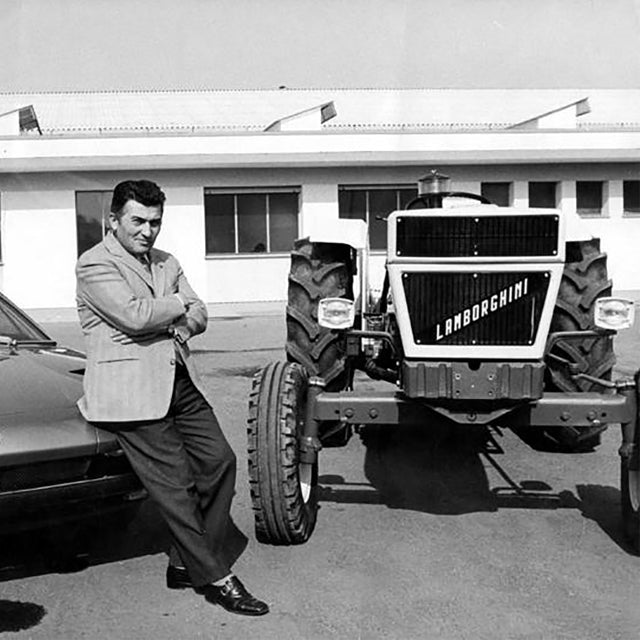Ferruccio Lamborghini was a blue-collar visionary, the type of man who all Petrolisti aspire to be. He built fast cars, made a bunch of money, and never even needed to incur a dime of student loan debt to do so. I kid, I kid. Ferruccio Lamborghini's lasting legacy stems from his work as a supercar builder, but despite his name adorning the rumps of Miuras and Aventadors from Bogota to Beijing, Lamborghini Automobili was simply the cherry on top of Ferruccio’s empire.


Born in 1916, Ferruccio dug into mechanics at a young age, tinkering with the family tractor on their farm, and eventually straying from the family farming business to attend technical school. He was scooped up in the draft during World War II and worked for the Italian Air Force as a mechanic, ultimately being held by the British in 1945 as a prisoner of war. They put him to work, too. With all of this hands-on experience providing him an intricate knowledge of both farm tractors and military vehicles, how would he possibly bring those two worlds together after the war? “Easy”, he probably would have said to himself, had he spoken English.
Soon after returning to Italy, Ferruccio opened a car and motorcycle repair shop, where he cobbled together a race-spec Fiat Topolino that he crashed in the Mille Miglia – an incident that scared him away from racing for decades and which prompted him to focus on less extreme pursuits. In the wake of World War II, there were plenty of military-grade machines lying around and Ferruccio started snatching up surplus equipment at rockbottom prices and converting the parts into tractors. Initially, he turned out one tractor per month from his small garage but, with business booming, he quickly outgrew this space. Lamborghini Trattori was born.
Ferruccio never lacked for self-confidence and insisted on perfection around his shop. He was so confident in his mechanical abilities that he would coordinate tractor pulls with local farmers to openly display the dominance of his product. Come 1949, the business had grown so dramatically that Ferruccio no longer needed to source war remnants for parts, and was able to open a legitimate production facility. Eventually, he would become one of the richest men in Italy thanks to his tractors.
It was also this confidence that led to the birth of Lamborghini Automobili. Despite crashing his Fiat in a race, Ferruccio remained a man who enjoyed his cars. One in particular, a Ferrari 250 GT, experienced frequent clutch maladies and Ferruccio figured he just need to go down to Maranello and take up the matter with Enzo Ferrari in person.
Accounts of this meeting differ. In some versions, Enzo is reported to have told Ferruccio that the problem was "not with the car, but with the driver," while other renditions claim that Enzo blew off Ferruccio entirely, refusing to meet with him. Either way, the display only fueled Ferruccio’s passions. He drove the 250 GT right to his factory and replaced the troublesome clutch with one from his tractors. With the heavier duty unit installed, the troubles were gone.
Knowing he could do better, Lamborghini took a slice of his fortune and dedicated his time to creating the best twelve-cylinder grand touring car the world had seen. With the aid of some former Ferrari talent, the car would debut at the 1964 Geneva Auto Show (where Lamborghini Automobili has unveiled all of their cars since) and it was dubbed the 350 GT. Production quickly followed and the gorgeous GT proved to be a success for the upstart automaker. Lamborghini produced 120 of the original 3.5-liter V12 cars between 1964 and 1966, and followed this up with the 4.0-liter 400 GT in 1966. The company would take further leaps forward in the years to come with the Miura and the Countach.
Unfortunately for Ferruccio, his golden age was short-lived. In the early 1970s the tractor business became ran into financial problems when two large orders were cancelled, one by Lamborghini Trattori’s South African importer and another by the unstable Bolivian military government. Trattori’s employees were unionized and thus could not be laid off. With no ability to restructure, Trattori was eventually sold to a rival company.
Meanwhile over at Automobili, business had slowed to a crawl as cost-cutting measures took effect and as the gas crisis took hold. Ferruccio proceeded to sell off his remaining stake in the car business as well, washing his hands of his namesake firm entirely.
Being the enterprising man that he was, though, Ferruccio had two other businesses to keep him busy, one providing heating and air conditioning units and services, and another manufacturing hydraulic equipment. Divested of the Trattori and Automobili businesses, he remained a part of these two ventures until finally retiring to his rural estate in 1974.
Ferruccio Lamborghini passed away in 1993 at the age of 76. Despite his absence from the automaker, Lamborghini Automobili has survived numerous brushes with death and continues to produce some of the most polarizing and sophisticated supercars on the road today. Lamborghini Trattori, now part of the SAME Deutz-Fahr group, also lives on. Wherever the afterlife might find Ferruccio Lamborghini, odds are he's gloating to Enzo Ferrari.





Image Sources: dailynewsdig.com, benzina.blog.pl, toranji.ir, dealer.com, blogspot.com, lamborghini.com, carstyling.ru




















































